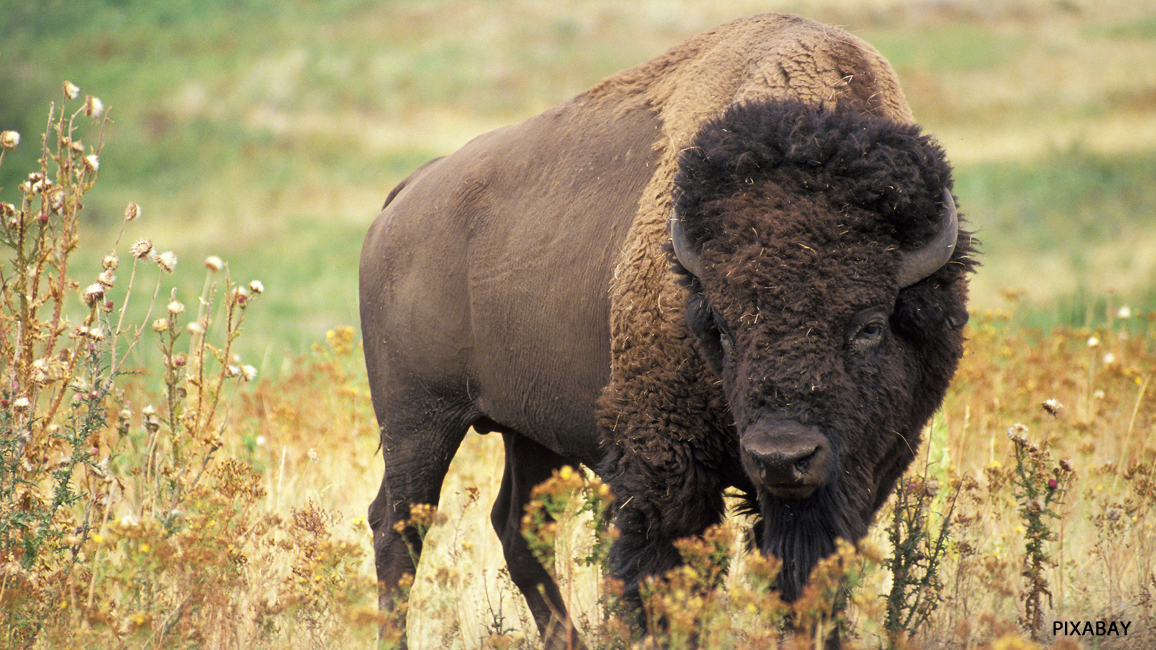
Better with Bison
By Kate HofmannMillions of American bison once roamed the Great Plains. Now these massive animals are returning, and they’re bringing big changes to the landscape—changes that help many other animals and plants thrive.

In 1800, North America was home to more than 40 million bison. By 1900, European settlers had hunted so many that just a few hundred were left. It was a huge loss. American bison are the largest land mammals in North America, and their importance is even bigger than they are. That’s why people are trying to bring them back to places where they once roamed.
Why are American bison so important? Here are just a few reasons:
• Bison graze their way across the plains, eating grasses and trampling the soil with their heavy hooves. The soil gets churned up and holds water better, making it easier for plants to grow.
• As a bison grazes, it poops—a lot! Every day, the average bison leaves behind as much as three gallons of dung. The dung is good fertilizer, full of nutrients that feed plants.
• Bison spread seeds, too. Seeds stick to their fur and then drop off somewhere new. Seeds eaten by the bison in one place come out in the bison’s dung in a new place. And as they roam, their hooves “plant” seeds by pushing them into the soil.
Keep reading to discover even more important things bison do.

BISON BRING FOOD
Bison graze for most of each day. They roam far and wide, and grasses are their main food. In areas where bison graze a lot, wildflowers and other plants have a better chance to grow. The more kinds of plants, the more food for other animals.
Meanwhile, even bison dung provides food! Flies and dung beetles lay their eggs in fresh patties. When the eggs hatch, wormlike larvae emerge and eat the dung. As many as 300 different species of insects might live in one bison patty.
Here’s another wild fact: Up to 3,000 new flies can come from one dung patty in two weeks! It may sound icky to us, but these flies become a huge source of food for all kinds of birds, bats, turtles, snakes, and toads.
BISON PROVIDE SHELTER
Bison also help create shelter for other animals. Many birds choose grazed areas for their nests. Some even line the nests with clumps of shed bison fur. The fur keeps chicks warm and covers their scent, protecting them from predators. Prairie dogs dig their underground burrows in places grazed and trampled by bison. Short grass makes it easier for them to keep watch for danger.
And bison dung? Well, that can be a house, too! Hard, dry patties become “roofs” for toads, mice, and snakes. These animals stay dry and cool and find lots to eat, thanks to all the insects that have already moved in.
- The mule deer enjoys the lush grasses and other plants that bison help to spread. Butterflies such as the monarch (circle) and bees visit wildflowers for their sweet nectar.
- Sandhill cranes find lots of tasty insects around bison dung. They also build their nests in open areas created by grazing bison.
- Horned lark chicks wait in their grassy nest for food.
- Bison grazing grounds are great places for black-tailed prairie dogs to dig burrows.
- Many creatures find shelter under dried dung patties.
BISON PLOW THROUGH SNOW
Weather on the Great Plains can be extreme, but bison have what it takes to survive. Thick, shaggy fur coats keep them warm during winter’s blizzards and biting cold. They are so well insulated that snow on their backs doesn’t even melt! They use their powerful heads as plows by swinging them back and forth through deep drifts. They are strong enough to dig down under the snow to reach grass to eat. Pronghorn, elk, and other animals then follow the bison trails.
BISON MAKE WALLOWS
During the hot summers, bison have another helpful habit. These massive animals—weighing as much as 2,000 pounds each—drop to the dusty ground and roll around. This helps them shed their winter coats and get rid of pesky flies. The dust also cools them down. What’s left on the ground is an area of bare, packed-down soil called a wallow.
When it rains, water collects in these low spots. The shallow pools become watering holes where many animals come to drink. Birds visit to collect mud for building their nests. Frogs and toads lay their eggs in the pools, and their tadpoles grow up there. Certain insects lay eggs in the water, too. The wallows are also good places for wildflowers to grow. The flowers then attract bees and butterflies with their sweet nectar.
If you could ask the plants and animals of bison country, they would surely all agree: When it comes to life on the Great Plains, everything is better with bison!
- The bison is “wallowing,” or rolling in the dust, to stay cool and free of pests.
- The bison plows through deep snow, leaving trails that other animals use.
- A barn swallow visits a bison wallow to collect mud for its nest. Frogs, toads, and insects lay their eggs in wallows.
- The bison and calf are using a wallow as a watering hole.

















